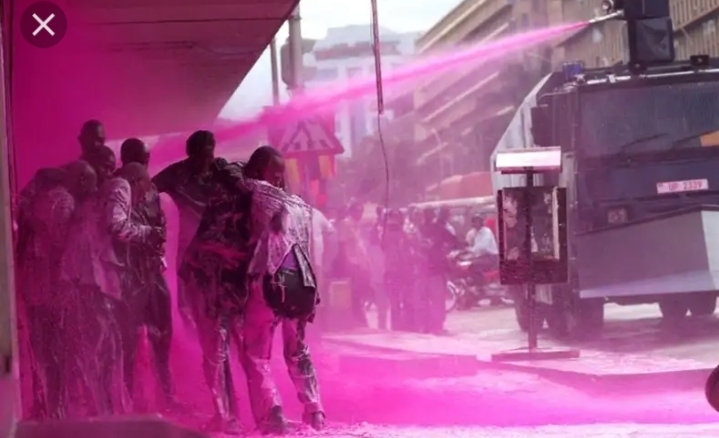police officers used water cannons to spray protesters with pink-dyed water during the Gen Z -led protests in Nairobi County.
Spraying protesters with dyed liquid is a trend witnessed in various countries worldwide, with police using the products to spot protesters afterwards easily.
One of the earliest records of pink dye in water cannons is in 1997 when South Korean and Indonesian police used it to disrupt demonstrators.
This was during the anti-China protests in Hong Kong, where people protested the introduction of a bill that amended the Fugitive Offenders Ordinance, which would allow the extradition of Hong-Kongers to mainland China if they committed a crime…Click Here To Continue Reading>> …Click Here To Continue Reading>>
Apart from pink, other usual colours used in water cannons are blue and purple. In 2019 and 2020, Hong Kong police officers used blue-dyed water to identify and detain protesters. READ FULL STORY HERE>>>CLICK HERE TO CONTINUE READING>>>
The stain and difficulty in washing off help the police spot protestors hours after the protest.
High- or low-velocity streams of water, commonly known as water cannons, are frequently used for dispersing crowds or limiting access to certain areas. Water cannons can cause hypothermia, direct trauma from the pressurized water, secondary injury from being knocked down or colliding with objects, or injuries from chemicals and dyes dissolved in the water. These medical problems — along with practical and human rights concerns about communication, intimidation, indiscriminate and disproportionate use, and collective punishment — highlight water cannons’ potential for misuse.
Modern water cannons can propel water at rates up to 20 liters per second, and can stream water 67 meters away. Different agents are sometimes mixed into water cannons to create secondary impacts: colored dyes, malodorous chemicals, and invisible UV markers are used as means of collective punishment or for the purpose of later identifying and arresting protestors.
Use of water cannon in riot control contexts can lead to injury or death, with fatalities recorded in Indonesia (in 1996, when the cannon’s payload contained ammonia),Zimbabwe (in 2007, when the use of cannons on a peaceful crowd caused panic), Turkey (in 2013, when the payload was laced with “liquid tear gas”),Ukraine (in 2014, with the death of activist and businessman Bogdan Kalynyak, reportedly catching pneumonia after being sprayed by a water cannon in freezing temperatures)and South Korea (in 2016, when a 68-year-old farmer died after injuries sustained by a water cannon the previous year)
Health Effects
Water cannons can affect the health of individuals in a number of ways:
- Hypothermia and Frostbite: In colder climates, the use of water cannons can cause hypothermia and frostbite.
- Internal injuries: Direct injuries can include traumatic or internal injuries from the force of the water stream.
- Falling and slipping: Indirect injuries from the blunt force of water cannons include forced falls and slipping.
- Exposure to added chemicals: Added chemicals can also have negative effects


 HEALTH & LIFESTYLE12 months ago
HEALTH & LIFESTYLE12 months ago
 METRO9 months ago
METRO9 months ago
 SPORTS10 months ago
SPORTS10 months ago
 SPORTS11 months ago
SPORTS11 months ago
 METRO3 months ago
METRO3 months ago
 HEALTH & LIFESTYLE11 months ago
HEALTH & LIFESTYLE11 months ago
 IN-THE-NEWS9 months ago
IN-THE-NEWS9 months ago
 SPORTS10 months ago
SPORTS10 months ago



